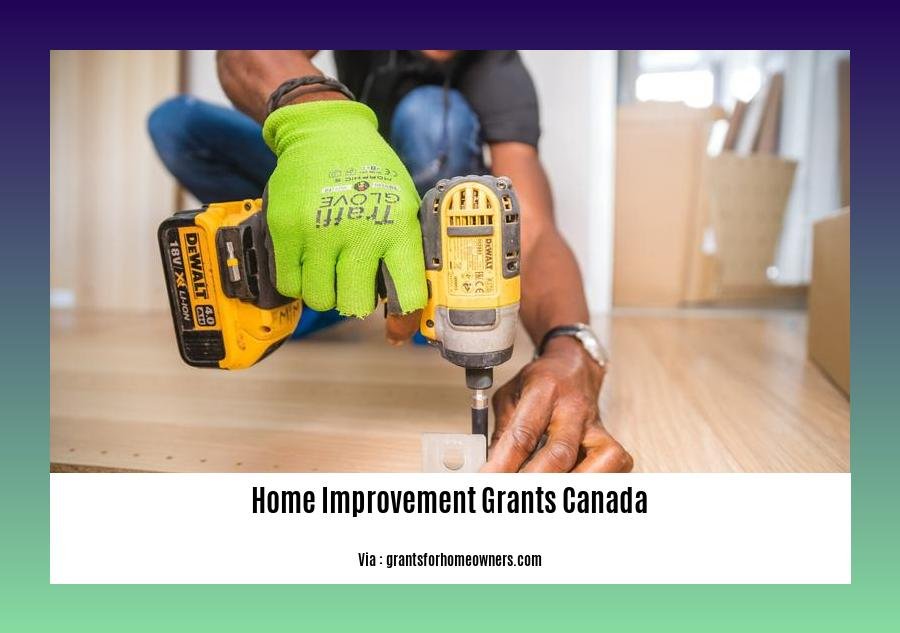In this comprehensive guide, we delve into the intricacies of home improvement grants available across Canada. Whether you’re dreaming of a kitchen makeover, an energy-efficient upgrade, or a transformative renovation, this guide will empower you with the knowledge and resources you need to navigate the grant landscape and unlock funding opportunities that can turn your home improvement aspirations into reality. Discover the grants that align with your project goals and financial situation, and learn how to craft a compelling application that will impress the grant providers. Unlock the potential of your home and embark on a journey of improvement with the valuable insights provided in this comprehensive guide: [- Home Improvement Grants Canada: A Comprehensive Guide for Homeowners].
Key Takeaways:
-
Home improvement and retrofit grants in Canada aim to reduce greenhouse gas emissions by encouraging energy-efficient home renovations.
-
The Canada Greener Homes Grant is a federal program that provides up to $5,600 to homeowners for energy-efficient retrofits.
-
Provincial home improvement grants also exist, with varying eligibility criteria and grant amounts.
-
To be eligible for these grants, homeowners usually need to meet specific income and property requirements.
-
Home renovation projects that qualify for grants often involve upgrades like insulation, windows, doors, heating systems, and renewable energy installations.
-
These home improvement grants are designed to help Canadians save money on energy bills and reduce their environmental impact.
Home Improvement Grants Canada

Navigating the world of home improvement grants in Canada can be a daunting task. With a plethora of programs, varying eligibility criteria, and application processes, it’s easy to feel overwhelmed. This comprehensive guide will simplify the process for you.
Understanding Home Improvement Grants Canada
Home improvement and retrofit grants in Canada are designed to help homeowners reduce greenhouse gas emissions by encouraging energy-efficient home renovations. By providing financial assistance, these grants aim to make sustainable home improvements more accessible and affordable.
Types of Home Improvement Grants Canada
1. Canada Greener Homes Grant:
- Federal program offering up to $5,600 for energy-efficient retrofits, including insulation, windows, and renewable energy installations.
2. Provincial Home Improvement Grants:
- Vary across provinces, with different eligibility criteria and grant amounts. Some common types include:
- Greener Homes Grant (Ontario): Up to $5,000 for energy-efficient home renovations.
- Home Renovation Tax Credit (British Columbia): Up to $1,500 for eligible home renovation expenses.
Eligibility Requirements
Eligibility for home improvement grants typically includes:
- Income Limits: Grants are often available to low and middle-income households.
- Property Requirements: Grants usually apply to principal residences only.
- Renovation Requirements: Specific types of energy-efficient renovations are often required.
Applying for Home Improvement Grants Canada
Applying for these grants involves:
- 1. Research: Familiarize yourself with available programs and their eligibility criteria.
- 2. Pre-Renovation Assessment: Some grants require an energy assessment before renovations begin.
- 3. Application Forms: Complete the relevant application forms for each grant you’re applying for.
- 4. Supporting Documentation: Gather necessary documents, such as proof of income and renovation quotes.
- 5. Submit Your Application: Follow the submission instructions for each grant program.
Tips for Success
To increase your chances of grant approval:
- Thorough Application: Ensure your application is complete and accurate.
- Supporting Documentation: Provide detailed quotes and documentation to support your renovation plans.
- Energy Assessment: Don’t skip the pre-renovation energy assessment if required.
Home improvement grants can significantly reduce the cost of energy-efficient home renovations. By understanding the available programs, eligibility requirements, and application process, you can successfully secure funding for your home improvement projects.
Are you looking to elevate your home’s aesthetics and functionality? Discover trusted home improvement contractors in Maryland who will transform your dreams into reality.
Remodeling your home can be a daunting task, but with our home improvement cost calculator, you can estimate project costs and make informed decisions about your renovation.
In Grand Rapids, find inspiration and innovative solutions for your home improvement needs. Explore our curated directory of home improvement experts who will bring your vision to life.
Enhance the beauty and comfort of your home with the help of Grand Rapids’ finest home improvement professionals. Discover a seamless home renovation experience with trusted local experts.
Are you a pensioner in Ireland seeking home improvement assistance? Learn about available grants and financial aid designed to support your home renovation projects. Explore home improvement grants for pensioners in Ireland and transform your living space.
Types of Home Improvement Grants Available in Canada

Hey there, home enthusiasts! Are you looking to spruce up your living space but need a little financial assistance? Look no further; Canada offers various home improvement grants to help you make those renovation dreams a reality.
Key Takeaways:
-
You can transform your home with these grants, from energy-efficient upgrades to accessibility modifications and more.
-
Dive into the details to discover which grant suits your specific renovation needs and eligibility criteria.
-
Dig into the application process, gather the required documents, and prepare to witness your dream home taking shape.
-
With a little effort and research, you’ll be on your way to securing funding for your home improvement projects.
Types of Home Improvement Grants in Canada:
- Canada Greener Homes:
-
Get up to $5,600 in grants for eco-friendly renovations like insulation, windows, and heating systems.
-
BC Rebate for Accessible Home Adaptations (BC RAHA):
-
Receive funding for safety modifications like handrails, grab bars, and wheelchair ramps.
-
BC Seniors’ Home Renovation Tax Credit:
-
BC seniors can claim tax credits for eligible home renovations that enhance accessibility and safety.
-
Residential Rehabilitation Assistance Program On-Reserve:
-
First Nations communities can access grants for home repairs and renovations.
-
Canada Mortgage and Housing Corporation’s Green Home Program:
- Incentives for energy-efficient home construction and renovations.
Application Process:
- Choose the Right Grant:
-
Research and select the grant that aligns with your renovation plans and eligibility criteria.
-
Prepare the Application:
-
Gather necessary documents like income proof, property details, and renovation quotes.
-
Submit Your Application:
-
Follow the instructions for each grant program and submit your application.
-
Await Approval:
- Be patient; the approval process may take some time.
If you’re unsure about the eligibility requirements or application process, don’t hesitate to seek assistance from the grant providers. They’re ready to guide you through the process.
Keep in mind, securing a grant may involve some paperwork, but it’s worth the effort. These grants are a fantastic opportunity to enhance your home while reducing renovation costs. Start exploring your options today and watch your home improvement dreams take flight!
Relevant URL Sources:
-
Home Renovation Grants: Which One Fits You? | National Bank
Leveraging Home Improvement Grants for Sustainable Renovations
Upgrading your home with energy-efficient features doesn’t have to be a heavy financial burden. Canada offers a variety of grants and incentives to help homeowners like you make sustainable renovations. Dive into this guide to understand these grants, their benefits, and how to apply.
Key Takeaways:
- Federal and Provincial Support: Explore federal and provincial programs tailored to your location to find suitable grants.
- Identify Eligible Renovations: Not all upgrades qualify; research specific improvements that meet the grant criteria.
- Income and Property Requirements: Eligibility may depend on income levels and property type; check program details.
- Pre-Renovation Audits: Certain programs require an energy assessment before renovations commence. Don’t miss out on this crucial step.
- Complete Application: Gather necessary documents and fill out application forms accurately and thoroughly to increase approval chances.
- Timeline Considerations: Grants often have seasonal application windows; stay updated and apply within the specified timeframe.
- Professional Guidance: If you’re unsure about anything, consult experts like contractors or energy advisors. They can provide valuable insights and ensure compliance with grant requirements.
Types of Home Improvement Grants in Canada: A Closer Look
1. Federal Grants:
- Canada Greener Homes Grant: A national program offering up to $5,600 for energy-efficient retrofits, including insulation, windows, and heating systems. Citation
2. Provincial Grants:
- British Columbia Home Renovation Tax Credit: A provincial tax credit of up to $1,500 for eligible home improvements, including energy-efficient upgrades and accessibility modifications. Citation
How to Apply for Home Improvement Grants: A Step-by-Step Guide
-
Research and Eligibility Check: Start by researching available grants in your area and assess your eligibility based on income, property type, and renovation requirements.
-
Choose Your Upgrades: Familiarize yourself with eligible home improvements that qualify for grants. Common renovations include insulation, windows, energy-efficient appliances, and renewable energy systems.
-
Pre-Renovation Assessment: If required by the grant program, arrange for an energy assessment of your home to identify potential energy-saving measures.
-
Application Preparation: Gather essential documents, such as income proof, property ownership details, and renovation quotes from qualified contractors.
-
Application Submission: Complete the grant application forms accurately, attaching all supporting documents. Submit your application within the specified timeframe to avoid missing out.
-
Approval and Disbursement: Once your application is approved, the grant amount will be disbursed to you via check or direct deposit, or credited to your utility bill.
-
Renovation Execution: Engage qualified contractors to carry out the approved renovations. Ensure the work aligns with grant requirements and building codes.
-
Post-Renovation Assessment: Some programs require a post-renovation energy assessment to verify the effectiveness of the upgrades. This may be necessary to receive the full grant amount.
By leveraging home improvement grants, you can transform your home into a more sustainable and energy-efficient haven while reaping financial savings. These grants are valuable tools that align with our collective responsibility to protect the environment and reduce our carbon footprint. Embark on your renovation journey with confidence, knowing that you’re contributing to a greener future for generations to come.
Maximizing Grant Approval Chances: Strategies for Success
Hey there, fellow home improvement enthusiasts! If you’re in Canada and looking to give your home a makeover, you might want to consider applying for a home improvement grant. These grants can provide valuable financial assistance for your renovation projects, helping you save money and make your home more comfortable and energy-efficient. If you’re not sure how to go about it, let me share some strategies to Maximize Your Grant Approval Chances.
Key Takeaways:
- Research potential grant opportunities that align with your project goals and location.
- Craft a compelling grant proposal that clearly outlines the project, its impact, and how it aligns with the funder’s priorities.
- Provide a detailed budget, timeline, and any required supporting documents to demonstrate your project’s feasibility.
- Proofread and revise your proposal thoroughly to ensure it is error-free and well-presented.
- Build relationships with grant makers and attend workshops to gain insights into their funding priorities and application process.
- Keep funders updated on your progress and accomplishments through regular communication.
- Implement a structured grant management system to track and manage all aspects of the grant lifecycle.
- Assign clear roles and responsibilities for grant management activities to ensure accountability.
- Establish a system for financial and programmatic reporting to meet funder requirements.
- Continuously evaluate and learn from your grant management practices to identify areas for improvement.
Building Strong Relationships:
Networking is crucial in the grant-seeking world. Attend workshops, webinars, and events to connect with grant makers and potential funders. Building relationships can provide you with valuable insights into their funding priorities and application process, increasing your chances of approval.
Effective Grant Management:
Once you’ve secured a grant, effective management is key to ensuring successful implementation and reporting. Create a structured system to track all aspects of the grant lifecycle, including project timeline, budget, and deliverables. Assign clear roles and responsibilities to team members to ensure accountability and maintain regular communication with funders to keep them updated on your progress.
Additional Tips:
- Proofread and revise your grant proposal thoroughly before submitting it. A well-presented and error-free proposal makes a positive impression on grant makers.
- Remember that grant applications are competitive, so make sure your project stands out by clearly demonstrating its impact and alignment with the funder’s priorities.
- Keep in mind that grant approval can take time, so be patient and persistent in your efforts.
Remember, applying for a home improvement grant can be a strategic and rewarding process. By implementing these strategies, you can increase your chances of securing funding for your renovation projects, transforming your home, and making it more comfortable and energy-efficient.
Citations:
– Grant Writing Academy: Maximizing Your Chances of Securing a Grant
– Nonprofit Pro: Best Practices for Securing a Nonprofit Grant
FAQ
Q1: What is the Canada Greener Homes Grant?
A1: The Canada Greener Homes Grant is a federal home renovation grant program offered by the Canadian government to homeowners and landlords. It provides financial assistance for home energy efficiency retrofits, upgrades, and renovations, such as insulation, windows, doors, heating systems, and renewable energy installations.
Q2: Who is eligible for the Canada Greener Homes Grant?
A2: To be eligible for the Canada Greener Homes Grant, homeowners and landlords must meet certain criteria, including:
– Owning a home in Canada
– Meeting minimum energy efficiency requirements
– Using an NRCan-registered energy advisor
– Completing eligible retrofits and upgrades
Q3: How much money can I get from the Canada Greener Homes Grant?
A3: The maximum grant amount you can receive from the Canada Greener Homes Grant is $5,600. The exact amount you’re eligible for will depend on the type and number of energy efficiency upgrades you undertake.
Q4: How do I apply for the Canada Greener Homes Grant?
A4: To apply for the Canada Greener Homes Grant, you must first hire an NRCan-registered energy advisor to conduct an energy assessment of your home. The energy advisor will provide you with an EnerGuide evaluation report, which you can then use to apply for the grant through the Natural Resources Canada website.
Q5: What are the benefits of using the Canada Greener Homes Grant?
A5: The benefits of using the Canada Greener Homes Grant include:
– Reducing your energy bills
– Increasing the comfort of your home
– Making your home more environmentally friendly
– Potentially increasing the value of your home
- Modern White Kitchen Backsplash: A Guide to Stylish Kitchen Designs - November 23, 2025
- White Backsplash Ideas: Simple Ways to Refresh Your Kitchen Space - November 22, 2025
- Kitchen Backsplash For White Kitchen: Ideas To Inspire Your Renovation - November 21, 2025










